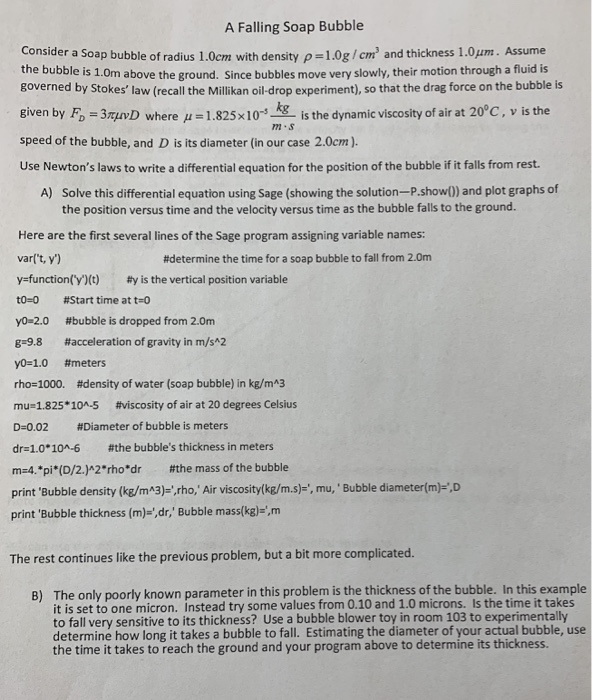use python programming to solve this problem

A Falling Soap Bubble der a soap bubble of radius 1.0cm with density p=1.0g/cm and thickness 1.0 um. Assume the bubble is 1. Om above the ground. Since bubbles move very slowly, their motion through a fluid is guverned by Stokes' law (recall the Millikan oil.drop experiment), so that the drag force on the bubble is given by Fo = 3 D where u 1.825x10" is the dynamic viscosity of air at 20C, v is the speed of the bubble, and D is its diameter (in our case 2.0cm). Use Newton's laws to write a differential equation for the position of the bubble if it falls from rest. A) Solve this differential equation using Sage (showing the solution--P.show()) and plot graphs of the position versus time and the velocity versus time as the bubble falls to the ground. Here are the first several lines of the Sage program assigning variable names: var('t, y') #determine the time for a soap bubble to fall from 2.0m y=function(y)) #y is the vertical position variable too #Start time at t=0 yo-2.0 Wbubble is dropped from 2.0m g=9.8 acceleration of gravity in m/s^2 yo=1.0 #meters rho=1000. #density of water (soap bubble) in kg/m^3 mu=1.825*10^-5 #viscosity of air at 20 degrees Celsius D=0.02 #Diameter of bubble is meters dr=1.0*10^-6 #the bubble's thickness in meters mw4.pi"(D/2.)2rho'dr the mass of the bubble print Bubble density (kg/m^3),rho,' Air viscosity(kg/m.s)=', mu,'Bubble diameter(m)=',D print 'Bubble thickness (m)=,dr,' Bubble mass(kg)', The rest continues like the previous problem, but a bit more complicated. B) The only poorly known parameter in this problem is the thickness of the bubble. In this example it is set to one micron. Instead try some values from 0.10 and 1.0 microns. Is the time it takes to fall very sensitive to its thickness? Use a bubble blower toy in room 103 to experimentally determine how long it takes a bubble to fall. Estimating the diameter of your actual bubble, use the time it takes to reach the ground and your program above to determine its thickness. A Falling Soap Bubble der a soap bubble of radius 1.0cm with density p=1.0g/cm and thickness 1.0 um. Assume the bubble is 1. Om above the ground. Since bubbles move very slowly, their motion through a fluid is guverned by Stokes' law (recall the Millikan oil.drop experiment), so that the drag force on the bubble is given by Fo = 3 D where u 1.825x10" is the dynamic viscosity of air at 20C, v is the speed of the bubble, and D is its diameter (in our case 2.0cm). Use Newton's laws to write a differential equation for the position of the bubble if it falls from rest. A) Solve this differential equation using Sage (showing the solution--P.show()) and plot graphs of the position versus time and the velocity versus time as the bubble falls to the ground. Here are the first several lines of the Sage program assigning variable names: var('t, y') #determine the time for a soap bubble to fall from 2.0m y=function(y)) #y is the vertical position variable too #Start time at t=0 yo-2.0 Wbubble is dropped from 2.0m g=9.8 acceleration of gravity in m/s^2 yo=1.0 #meters rho=1000. #density of water (soap bubble) in kg/m^3 mu=1.825*10^-5 #viscosity of air at 20 degrees Celsius D=0.02 #Diameter of bubble is meters dr=1.0*10^-6 #the bubble's thickness in meters mw4.pi"(D/2.)2rho'dr the mass of the bubble print Bubble density (kg/m^3),rho,' Air viscosity(kg/m.s)=', mu,'Bubble diameter(m)=',D print 'Bubble thickness (m)=,dr,' Bubble mass(kg)', The rest continues like the previous problem, but a bit more complicated. B) The only poorly known parameter in this problem is the thickness of the bubble. In this example it is set to one micron. Instead try some values from 0.10 and 1.0 microns. Is the time it takes to fall very sensitive to its thickness? Use a bubble blower toy in room 103 to experimentally determine how long it takes a bubble to fall. Estimating the diameter of your actual bubble, use the time it takes to reach the ground and your program above to determine its thickness








